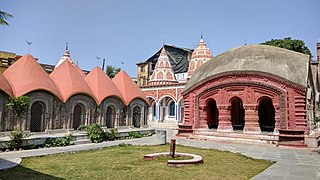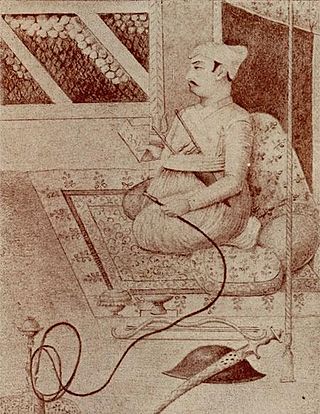Related Research Articles

Warren Hastings was a British colonial administrator, who served as the first Governor of the Presidency of Fort William (Bengal), the head of the Supreme Council of Bengal, and so the first Governor-General of Bengal in 1772–1785. He and Robert Clive are credited with laying the foundation of the British Empire in India. He was an energetic organizer and reformer. In 1779–1784 he led forces of the East India Company against a coalition of native states and the French. In the end, the well-organized British side held its own, while France lost influence in India. In 1787, he was accused of corruption and impeached, but he was eventually acquitted in 1795 after a long trial. He was made a Privy Councillor in 1814.

Mirza Muhammad Siraj-ud-Daulah, commonly known as Siraj-ud-Daulah or Siraj ud-Daula, was the last independent Nawab of Bengal. The end of his reign marked the start of the rule of the East India Company over Bengal and later almost all of the Indian subcontinent.

Murshidabad is a historical city in the Indian state of West Bengal. It is located on the eastern bank of the Bhagirathi River, a distributary of the Ganges. It forms part of the Murshidabad district.

The Belvedere Estate consists of Belvedere House and the 30-acre (12 ha) grounds surrounding it. It is located in Alipore, near the zoo, in Kolkata. In 1858, after the Governor-General moved out, the Lieutenant-Governor of Bengal took up residence in Belvedere House. When the capital moved from Kolkata to Delhi in 1911, the Lieutenant-Governor of Bengal, who had hitherto resided in Belvedere House, was upgraded to a full governor and transferred to Government House. Belvedere House has been the home of the National Library of India since 1948.

The Nawab of Bengal was the hereditary ruler of Bengal Subah in Mughal India. In the early 18th-century, the Nawab of Bengal was the de facto independent ruler of the three regions of Bengal, Bihar and Orissa which constitute the modern-day sovereign country of Bangladesh and the Indian states of West Bengal, Bihar and Odisha. The Bengal Subah reached its peak during the reign of Nawab Shuja-ud-Din Muhammad Khan. They are often referred to as the Nawab of Bengal, Bihar and Orissa. The Nawabs were based in Murshidabad which was centrally located within Bengal, Bihar, and Odisha. Their chief, a former prime minister, became the first Nawab. The Nawabs continued to issue coins in the name of the Mughal Emperor, but for all practical purposes, the Nawabs governed as independent monarchs. Bengal continued to contribute the largest share of funds to the imperial treasury in Delhi. The Nawabs, backed by bankers such as the Jagat Seth, became the financial backbone of the Mughal court.

Berhampore, also known as Baharampur, is a city and a municipality in the state of West Bengal, India. Berhampore is the administrative headquarters of the Murshidabad district. As of 2011 census, Berhampore is the seventh largest city in West Bengal. It is located about 200 km (124 mi) from Kolkata, the state capital.

Cossimbazar is a sub-urban area of Berhampore city in the Berhampore CD block in the Berhampore subdivision of Murshidabad district in the Indian state of West Bengal.
Sir Francis Sykes, 1st Baronet (1732–1804) was an English country landowner and politician who sat in the House of Commons between 1771 and 1804. He was sometime Governor of Cossimbazar in India, being styled an English nabob by his peers.

Mir Qasim was the Nawab of Bengal from 1760 to 1763. He was installed as Nawab with the support of the British East India Company, replacing Mir Jafar, his father-in-law, who had himself been supported earlier by the East India Company after his role in winning the Battle of Plassey for the British. However, Mir Jafar eventually ran into disputes with the East India Company and attempted to form an alliance with the Dutch East India Company instead. The British eventually defeated the Dutch at Chinsura and overthrew Mir Jafar, replacing him with Mir Qasim. Qasim too later fell out with the British and fought against them at Buxar. His defeat has been suggested as a key reason in the British becoming the dominant power in large parts of North and East India.

Murshidabad district is a district in the Indian state of West Bengal. Situated on the left bank of the river Ganges, the district is very fertile. Covering an area of 5,341 km2 (2,062 sq mi) and having a population 7.103 million, it is a densely populated district and the ninth most populous in India. Berhampore city is the headquarters of the district.

Archibald Seton was a Scottish East India Company colonial administrator, Resident and Civil servant.

The Bengal Subah, also referred to as Mughal Bengal, was the largest subdivision of the Mughal Empire encompassing much of the Bengal region, which includes modern-day Bangladesh, the Indian state of West Bengal, and some parts of the present-day Indian states of Bihar, Jharkhand and Odisha between the 16th and 18th centuries. The state was established following the dissolution of the Bengal Sultanate, a major trading nation in the world, when the region was absorbed into the Mughal Empire. Bengal was the wealthiest region in the Indian subcontinent.

Maharaja Sir Manindra Chandra Nandy was the Maharaja of Cossimbazar Raj from 1898 to 1929, a philanthropist and reformist during the period of Bengal Renaissance.
Maharani Swarnamoyee was the Maharani of Cossimbazar Raj from 1844 to 1897. She was a philanthropist during the period of Bengal Renaissance.
Sribati G.K. High School is a government high school located in Sribati, Katwa II, Bardhaman District, West Bengal, India. Established in 1867, it is one of the oldest schools in the area, and offers co-educational classes up to the tenth grade. It is the only educational institution in Sribati.
Nandy or Nandi is a Bengali surname which is found among the Bengali Kayasthas and Tilis in Indian States of West Bengal, Assam,Tripura and in Bangladesh.

Srish Chandra Nandy was the last zamindar of Cossimbazar Raj and a writer, politician and landlord of Bengal.

Chhanabora is a sweetmeat from the Indian subcontinent made from chhena and syrup. It is attested from the 16th century. It is related to rosogolla and pantua, sharing a cottage cheese basis with the former and a burnt brown crust with the latter. According to local legend, it was created when Maharaja Manindrachandra Nandi of Cossimbazar ordered his cook to create a dessert that was neither rosogolla nor pantua. It is common in Murshidabad and outsize chhanabora are a common gift for high-ranking visitors.

Rafa'at wa Awal-i-Martabat Maharaja Shri Chet Singh Sahib Bahadur, commonly known as Raja Chet Singh, a Bhumihar Brahmin king from the Narayan dynasty, was 3 rd ruler of Kingdom of Benaras in northern India.

Gokul Chandra Ghoshal was a native official of the East India Company who became a prominent and influential landlord by abusing his position and founded the Bhukailash Estate. He and Devi Singh, Diwan of Rangpur, were part of a number of rent collectors of the East India Company who became notorious for their corruption. Ghoshal had become wealthy and powerful through using his link to the East India Company.
References
- ↑ Noonan, John Thomas (1987-01-01). Bribes. University of California Press. p. 407. ISBN 978-0-520-06154-5.
- ↑ Bayly, C. A.; Bayly, Christopher Alan (1987). Indian Society and the Making of the British Empire. Cambridge University Press. p. 55. ISBN 978-0-521-38650-0.
- ↑ Markovits, Claude (2004-02-01). A History of Modern India, 1480-1950. Anthem Press. p. 246. ISBN 978-1-84331-004-4.
- ↑ Caṭṭopādhyāẏa, Baṅkimacandra (1895). Krishna Kanta's Will. T. Fisher Unwin.
- ↑ "East India Company at Home Project Cast Study" (PDF). ucl.ac.uk. Retrieved 12 January 2022.
- 1 2 3 4 "The Indian Seal Case Study: The Banian". blogs.ucl.ac.uk. Retrieved 2022-01-12.
- 1 2 3 4 Islam, Sirajul (18 June 2021). "Kasimbazar Raj". Banglapedia . Retrieved 12 January 2022.
- 1 2 Beveridge, Henry (1886). The Trial of Maharaja Nanda Kumar: A Narrative of a Judicial Murder. Thacker, Spink. p. 245.
- ↑ Calcutta Review. University of Calcutta. 1901. p. 52.
- ↑ Experts, Disha (2021-07-01). Blissful West Bengal General Knowledge for WBPSC, WBSSC & other Competitive Exams. Disha Publications. p. 36. ISBN 978-93-90711-02-4.
- ↑ Rungta, Radhe Shyam (1970). The Rise of Business Corporations in India, 1851-1900. CUP Archive. p. 58.
- ↑ Datta, Rajat (2008). Rethinking a Millennium: Perspectives on Indian History from the Eighth to the Eighteenth Century : Essays for Harbans Mukhia. Aakar Books. p. 336. ISBN 978-81-89833-36-7.
- ↑ Marshall, P. J. (2006) [First published 1987]. Bengal: The British Bridgehead: Eastern India 1740-1828. The New Cambridge History of India. Vol. II.2. Cambridge University Press. p. 146. ISBN 978-0-521-02822-6.
- ↑ Chakrabarti, Kunal; Chakrabarti, Shubhra (2013-08-22). Historical Dictionary of the Bengalis. Scarecrow Press. p. 96. ISBN 978-0-8108-8024-5.
- 1 2 Walsh, J. H. Tull (1902-01-01). A history of Murshidabad District (Bengal) : with biographies of some of its noted families. Dalcassian Publishing Company. p. 206.
- ↑ Dirks, Nicholas B. (2009-06-30). The Scandal of Empire: India and the Creation of Imperial Britain. Harvard University Press. p. 226. ISBN 978-0-674-03426-6.
- ↑ "Life and times of Cantoo Baboo (Krishna Kanta Nandy), the banian of Warren Hastings : period covered, 1742-1804". 東京外国語大学附属図書館OPAC. Retrieved 2022-01-12.